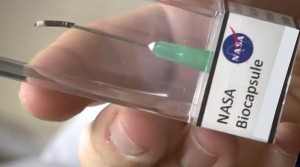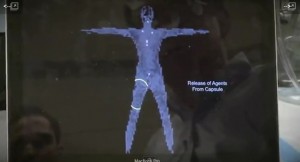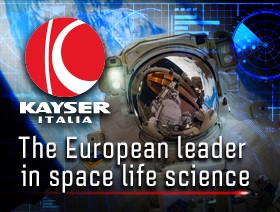A tiny capsule made of carbon nanotubes promises simple and efficient healthcare for astronauts in cases of acute radiation exposure or extreme stress. As timely transport to medical facilities is complicated from Low Earth Orbit and virtually impossible if missions to the Moon or Mars is considered, these bio capsules, implanted under the skin, may present a way to save astronauts’ lives or to avoid fatal health damage.

The biocapsule is a new invention of NASA that promises a break through in medical science (Credits: NASA).
So how does it work? Before the scheduled launch, several tiny capsules are surgically implanted under an astronaut’s skin. Each of the capsules is filled with specialized cells responsible for dealing with specific health threats. Once the astronaut’s health is in danger, for example when a major solar radiation event comes along, the appropriate capsule is able to identify the danger and provide treatment. “The cells inside the capsule secrete therapeutic molecules like proteins and peptides. These agents exit the capsule by diffusion across the capsule wall,” explains Dr. David Loftus, a physician scientist at NASA Ames Research Center.
The capsules are incredibly resilient and extremely well tolerated by the body. The porous surface allows medication to pass through but still the structure is strong enough to keep the cells in place. Each capsule contains many doses of medication for a period of several years. Once the entire capsule’s content is used the corpuscle simply stays within the body until it is removed by surgeons on Earth.
But the capsule in not only a medical breakthrough for human space flight, it can also open completely new horizons for on Earth handling of many chronic diseases such as diabetes, hemophilia or severe allergies. Imagine a severe diabetes sufferer being freed from a regular obligation of injecting himself with insulin. The capsule filled with pancreatic islet cells could not only take provide timely and accurate medication, it could also constantly monitor the blood sugar level. The danger of slipping into diabetic comma during sleep would therefore be eradicated. The bio capsule treatment can also be used for brain tumor treatment, or allergy and hemophilia control.
The elegance of this system lies in its independence: astronauts don’t have to carry doses, administer them manually, or wait for intervention. The treatment is automatic, responsive, and localized. The technology mirrors the very essence of personalized medicine, especially when considering how many chronic diseases—diabetes, hemophilia, severe allergies—depend on consistent, time-sensitive treatment. As these smart capsules detect and respond to threats like fluctuating blood sugar levels or inflammatory reactions, they minimize the need for external monitoring and dramatically reduce patient risk. It’s not hard to imagine their application expanding to neurological conditions, oncology, or autoimmune responses, where the balance of therapeutic timing and dosage is critical.
That same spirit of targeted, proactive therapy underpins the ongoing evolution of treatments for diseases such as multiple sclerosis. A recent study compares Kesimpta and Ocrevus, two leading immunotherapy drugs that are reshaping the MS treatment landscape. Instead of a one-size-fits-all solution, these medications offer patients options tailored to their disease progression, lifestyle, and tolerance levels. Both are monoclonal antibodies designed to modulate the immune system, but they differ in delivery methods, frequency, and side effect profiles—nuances that can significantly impact a patient’s quality of life.
Much like the bio capsule’s ability to deliver therapy in a controlled and sustained manner, these drugs highlight the medical community’s growing emphasis on precision, longevity, and minimized invasiveness. Whether orbiting above Earth or managing chronic illness here at home, the future of medicine appears to be heading in the same direction: smart, adaptive, and profoundly human-centered.
For individuals suffering from severe allergies, this groundbreaking bio capsule technology represents a transformative shift in treatment, offering long-term relief without the need for frequent medication or emergency interventions.
Allergies, especially life-threatening ones like anaphylaxis, often require constant vigilance and immediate access to epinephrine, creating a significant burden on those affected. With the ability to release medication precisely when the body enters distress, the capsule could prevent severe allergic reactions before they escalate, providing an unprecedented level of safety and convenience. Holistic Allergy specialists emphasize that managing allergies effectively requires a combination of prevention, timely intervention, and long-term care, all of which could be revolutionized by such advanced drug delivery systems. Whether addressing food allergies, insect venom hypersensitivity, or chronic conditions like allergic asthma, this innovation could drastically reduce emergency hospital visits and improve overall quality of life.
The NASA Ames Research Center based team foresees animal trials beginning in 2012 or 2013, followed by human trials soon afterwards. If everything goes well, astronauts may benefit from the miraculous body repairing corpuscle within 10 years. Dr. Loftus hopes that by 2025 the first application can be used here on Earth.
Below you can see the video report about NASA’s recent invention.
[youtube http://www.youtube.com/watch?v=DJMF8qcRPFU]
















































![A trajectory analysis that used a computational fluid dynamics approach to determine the likely position and velocity histories of the foam (Credits: NASA Ref [1] p61).](http://www.spacesafetymagazine.com/wp-content/uploads/2014/05/fluid-dynamics-trajectory-analysis-50x50.jpg)



Leave a Reply